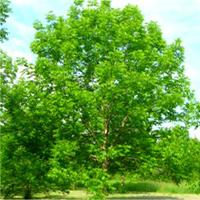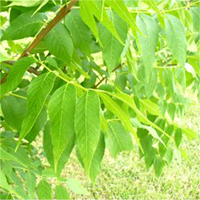Blue ash (Species at Risk)
Scientific name: Fraxinus quadrangulata




Cover photos credit: Tree: Sean Fox; Leaf: Sean Fox; Bark: Sean Fox; and Fruit: Melissa Spearing.
Status
Threatened
“Threatened” means the species lives in the wild in Ontario, is not endangered, but is likely to become endangered if steps are not taken to address factors threatening it.
Date added to the Species at Risk in Ontario List
The Blue Ash was already assessed as a species of special concern when the Endangered Species Act took effect in 2008. On June 15, 2016 the species was listed as threatened.
Read the assessment report (PDF)
What it looks like
The Blue Ash is a medium-sized tree with a straight, slender trunk supporting a narrow, rounded crown. Blue Ash grows 15 to 20 metres tall and the trunk is 15 to 25 centimetres in diameter. The bark is greyish and scaley. The leaves are opposite and compound, each with five to 11 leaflets. The leaflets are elongated, oval in shape, and have coarsely toothed edges.
Blue Ash grows quickly and can live 125 to 150 years.
Where it lives
In Ontario, Blue Ash grows in deciduous floodplain forests, and along sandy beaches and on limestone outcrops associated with Lake Erie.
Where it’s been found in Ontario
The range of Blue Ash extends from southwestern Ontario south to Oklahoma and Georgia. In Canada, it occurs only in southwestern Ontario, at the northern limits of its range, where about 56 occurrences are known.
View a larger version of this map (PDF)
What threatens it
Historically, forest removal was the main cause of the decline of this species in Ontario. Harvesting of large seed-producing trees may also have contributed to local declines. More recently, the invasive beetle, Emerald Ash Borer, has been a threat to this and other ash species. There is some evidence that Blue Ash is at lower risk to Emerald Ash Borer attack. In tests of both feeding preference and choice of egg-laying locations, a number of studies found it to be less attractive to Emerald Ash Borer than Green or White Ash (Haack et al. 2005, Anulewicz 2006, Pureswaran and Poland 2009). But with the eventual loss of these alternative hosts, it may face severe impacts.
Action we are taking
Threatened species and their general habitat are automatically protected.
Recovery strategy
A recovery strategy advises the ministry on ways to ensure healthy numbers of the species return to Ontario.
Read the executive summary and full document (December 13, 2017).
Government response statement
A government response statement outlines the actions the government intends to take or support to help recover the species.
Read the government response statement (December 21, 2018)
Review of Progress
A review of progress made toward protecting and recovering a species is required no later than the time specified in the species’ government response statement, or not later than five years after the government response statement is published if no time is specified.
Read the report on progress towards the protection and recovery of 11 species at risk, including Blue ash (2023).
What you can do
Report a sighting
- Report a sighting of an endangered animal or plant to the Natural Heritage Information Centre. Photographs with specific locations or mapping coordinates are always helpful.
Volunteer
- Volunteer with your local nature club or provincial park to participate in surveys or stewardship work focused on species at risk.
Be a good steward
- Private land owners have a very important role to play in species recovery. You may be eligible for stewardship programs that support the protection and recovery of species at risk and their habitats.
- The Carolinian forests of southern Ontario support an amazing diversity of plants and wildlife, including many species at risk. Carolinian Canada is working to help recover species at risk and their habitats. For more information, visit: www.carolinian.org/SpeciesHabitats.htm.
Report illegal activity
- Report any illegal activity related to plants and wildlife to 1-877-TIPS-MNR (847-7667).
Quick facts
- The species' scientific epithet, quadrangulata, refers to the tree’s distinctive four-angled twigs. Blue Ashes are also called Four-angled Ash.
- Blue Ash is named for the dye which can be extracted by mashing and cooking the inner trunk bark. It was used by First Nations and early European settlers.
- Because of its dense wood, Blue Ash was prized for speciality uses such as tool handles.
- Ash trees belong to the same family as olive trees and the familiar forsythias and lilacs of gardens.
- Blue Ash is sometimes planted as an ornamental shade tree.
